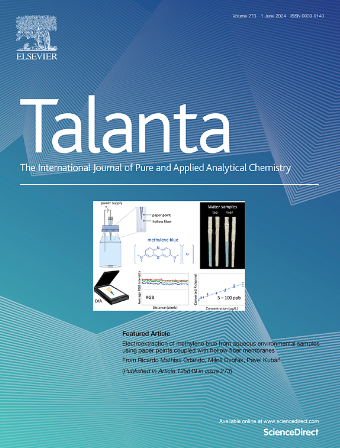罗丹明B负载透明质酸偶联二硫化钼纳米片用于检测人尿和活细胞中透明质酸酶活性
IF 5.6
1区 化学
Q1 CHEMISTRY, ANALYTICAL
引用次数: 0
摘要
有效的分子加载到纳米材料上是先进生物传感和成像的关键步骤,因为所得到的纳米探针提高了灵敏度和增强了靶向性。与其他纳米材料相比,二硫化钼纳米片具有表面积大、硫缺陷丰富等独特优势。在此,我们探索了MoS2 NSs与巯基偶联透明质酸(HA-SH)的结合,以选择性检测透明质酸酶(HAase)和特异性结合CD44受体阳性癌细胞。Rhodamine B (RhB)分子通过静电和疏水耦合到HA-SH-MoS2 NS表面,结合常数为7.14 × 1016 M−1。吸附RhB分子的HA-SH-MoS2 ns介导的荧光猝灭是通过静态猝灭和动态猝灭的组合进行的,其比例为10:1。在加入HAase后,吸附的RhB分子通过HAase介导的HA-SH水解从RB-HA-SH-MoS2 NSs中释放出来。因此,RhB分子的荧光恢复与HAase浓度成正比。RhB-HA-SH-MoS2 NSs对HAase的检出限为0.37 U/mL,线性响应范围为0.05 ~ 4.5 U/mL,对潜在干扰具有良好的选择性。RhB-HA-SH-MoS2 NSs不仅可以有效地定量尿样品中的HAase,还可以通过CD44受体介导的内吞噬作用对细胞内HAase活性进行选择性成像。本文章由计算机程序翻译,如有差异,请以英文原文为准。

Loading of hyaluronic acid–conjugated MoS2 nanosheets with rhodamine B for sensing hyaluronidase activity in human urine and live cells
Efficient molecule loading onto nanomaterials is a key step for advanced biosensing and imaging because of improved sensitivity and enhanced targeting of the resultant nanoprobe. In contrast to other nanomaterials, MoS2 nanosheets (NSs) possess unique advantageous of large surface area and abundant sulfur defects. Herein, we explored the conjugation of MoS2 NSs with thiol-conjugated hyaluronic acid (HA-SH) for selective detection of hyaluronidase (HAase) and specific binding to CD44 receptor-positive cancer cells. Rhodamine B (RhB) molecules were electrostatically and hydrophobically coupled to the HA–SH–MoS2 NS surface with a binding constant of 7.14 × 1016 M−1. The HA–SH–MoS2 NS-mediated fluorescence quenching of the adsorbed RhB molecules proceeds via a combination of static and dynamic quenching in the ratio of 10:1. Upon the addition of HAase, the adsorbed RhB molecules are liberated from the RB-HA–SH–MoS2 NSs via HAase-mediated hydrolysis of HA-SH. As a result, the restored fluorescence of RhB molecules is proportional to the HAase concentration. The RhB-HA–SH–MoS2 NSs achieve a detection limit of 0.37 U/mL for HAase with a linear response range from 0.05 to 4.5 U/mL and satisfactory selectivity against potential interferents. The RhB-HA–SH–MoS2 NSs not only effectively quantify HAase in urine sample but also enable selective imaging of intracellular HAase activity through CD44 receptor-mediated endocytosis.
求助全文
通过发布文献求助,成功后即可免费获取论文全文。
去求助
来源期刊

Talanta
化学-分析化学
CiteScore
12.30
自引率
4.90%
发文量
861
审稿时长
29 days
期刊介绍:
Talanta provides a forum for the publication of original research papers, short communications, and critical reviews in all branches of pure and applied analytical chemistry. Papers are evaluated based on established guidelines, including the fundamental nature of the study, scientific novelty, substantial improvement or advantage over existing technology or methods, and demonstrated analytical applicability. Original research papers on fundamental studies, and on novel sensor and instrumentation developments, are encouraged. Novel or improved applications in areas such as clinical and biological chemistry, environmental analysis, geochemistry, materials science and engineering, and analytical platforms for omics development are welcome.
Analytical performance of methods should be determined, including interference and matrix effects, and methods should be validated by comparison with a standard method, or analysis of a certified reference material. Simple spiking recoveries may not be sufficient. The developed method should especially comprise information on selectivity, sensitivity, detection limits, accuracy, and reliability. However, applying official validation or robustness studies to a routine method or technique does not necessarily constitute novelty. Proper statistical treatment of the data should be provided. Relevant literature should be cited, including related publications by the authors, and authors should discuss how their proposed methodology compares with previously reported methods.
 求助内容:
求助内容: 应助结果提醒方式:
应助结果提醒方式:


